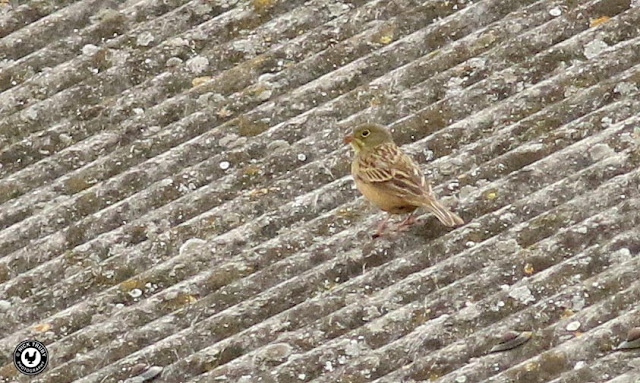 |
| Ortolan Bunting, Courtesy of Jim Hutchins |
While waiting for updates we popped into the BBOWT reserve at nearby Calvert to see if the pair of Black-necked Grebes were still present so that Mrs Caley could add them to her year list, I had seen them the day before since I was working nearby. The Grebes were indeed still there and I took a few quick record shots.
 |
| Black-necked Grebe |
With it now being mid morning the morning rush was well over and we sailed trouble free along the M25 and A12. The last leg of the journey was slower since every farmer, tandem bicyclist. horseman and horsewoman decided that it'd be a good time to go out on the minor roads and thus get in our way! But we still managed to pull into the Billett's Farm car park just before midday and within just a couple of minutes were looking at our first ever Ortolan Bunting, nudging me one closer to 400 species seen in the UK and on to 196 for the year.
 |
| Ortolan Bunting, Abberton Reservoir, 25/04/2019 |
We watched the Ortolan for a few minutes until it disappeared into the farmyard junk. We needed a comfort break and a coffee so headed the short way to the Essex Wildlife Trust on the other side of the reservoir. From the windows there we could see large numbers of Terns feeding over the water and a regular assured us that there were a few Black Terns amongst them, giving us an opportunity to add those to our year list once we'd finished with our lunch. In the car park I set up the scope and after a bit of searching locked onto a Black Tern way out in the middle of the reservoir. Not the best views we've ever had of them but the year list notched up to 197.
We intended to go back and have another look at the Ortolan Bunting but first stopped on the Layer de la Haye Causeway to see what might be around. Long-tailed Ducks and a Ring-necked Duck had been reported there in recent days but there was no sign of either for us. I scanned the larger part of the reservoir and found at least 5 Black Terns amongst the plethora of Common Terns and Gulls. The Terns were too far out to attempt any photography so I turned my attention to the spit of land that juts out into the reservoir. There were sleeping Teal and Mallards and then I got a very welcome surprise when I spotted 3 Whimbrel also resting on the grassy bank. Whimbrel are a bird that captivate me every time I see them, perhaps because they are so few and far between in landlocked Oxfordshire and when they do turn up nearer to home I always seem to miss them. The Whimbrel were a long way out but I managed a record shot and the year list counter went up to a 198.
 |
| Whimbrel |
 |
| Little Ringed Plover |
 |
| Common Tern |
Back at the farm there was no immediate sign of the Ortolan Bunting but other folk assembled there were trained on a Yellow Wagtail in the field on the northern side of the track. This turned out to be a "Channel" Wagtail, the hybrid produced by the interbreeding of the nominate flavissima (Blue-headed) with our own flava subspecies. We've seen a few of these "Channel" Wagtails now, they are delightful little birds. The Wagtail rewarded its admirers by flying into a small garden where it afforded some really nice views.
 |
| "Channel" Wagtail |
The Ortolan flew off out of sight so we diverted our intent back to the "Channel" Wagtail again and I took a few shots of it flying low to the ground. There were "normal" Yellow Wagtails here too.
 |
| "Channel" Wagtail |
 |
| Yellow Wagtail |
After the bird had flown to another perch in its territory I realised that the extender was still attached to the lens, normally not a good thing but this time it had probably worked in my favour since the light had been good enough now the sun had come out. We followed the song around to the wood yard just 50 yards or so away and spotted the same Nightingale (or another) singing away from another small tree. It was in direct competition with at least 2 others in a very small area. A friend of mine had told me that Fingringhoe Wick was a top spot for Nightingales and he certainly hadn't lied!
Of course, Nightingales are not always so showy and some take a bit of finding when they sing hidden in the undergrowth and scrubby bushes.
We had only an hour on site but had seen or heard at least 8 different Nightingales, some out in plain view others completely hidden, as well as many other birds such as Lesser Whitethroat and Cuckoo. Bearing in mind that a regular place that we traditionally visit, Paxton Pits, has experienced a major decline in our most famous of songbirds, we made a note to have a day out to Fingringhoe Wick again next year. It is well worth visiting to hear those Nightingales which had made it 199 on that year list. I wonder what bird would become the 200th!

















No comments:
Post a Comment